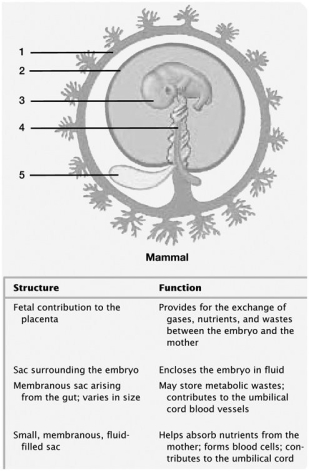A) a morula
B) a zygote
C) the formation of organs
D) a three-layered embryo
E) a blastula
G) D) and E)
Correct Answer

verified
Correct Answer
verified
True/False
The amnion forms the watery environment that encloses the embryo. True or False?
B) False
Correct Answer

verified
Correct Answer
verified
Essay
A recent series of TV commercials promoted the idea that a woman who wants to have a healthy baby must begin to eat well and avoid some medications and alcohol before she knows she is pregnant. Why?
Correct Answer

verified
Gastrulation and differentiation of embr...View Answer
Show Answer
Correct Answer
verified
View Answer
Multiple Choice
The dorsal lip of the blastopore:
A) becomes the neural tube.
B) becomes the digestive tract.
C) induces the surrounding cells to differentiate.
D) forms the chorion.
E) lacks the genes necessary to develop the embryo.
G) D) and E)
Correct Answer

verified
Correct Answer
verified
True/False
The extraembryonic membrane that sends blood vessels into the endometrium is the chorion. True or False?
B) False
Correct Answer

verified
Correct Answer
verified
Multiple Choice
In humans, implantation occurs:
A) just prior to fertilization.
B) immediately after fertilization.
C) when the embryo is a blastocyst.
D) when the embryo is a gastrula.
E) after the formation of the neural tube.
G) A) and D)
Correct Answer

verified
Correct Answer
verified
Multiple Choice
 -The structure labeled 2 is the:
-The structure labeled 2 is the:
A) chorion.
B) amnion.
C) embryo.
D) allantois.
E) yolk sac.
G) B) and D)
Correct Answer

verified
Correct Answer
verified
Essay
The mother's part of the placenta is derived from the ________.
Correct Answer

verified
Correct Answer
verified
Essay
Proteins called ________ bind to the DNA near the promoter regions where gene transcription begins.
Correct Answer

verified
transcript...View Answer
Show Answer
Correct Answer
verified
View Answer
Essay
A human embryo has webbed fingers. Why are human babies not usually born with webbed fingers?
Correct Answer

verified
During development, ...View Answer
Show Answer
Correct Answer
verified
View Answer
Multiple Choice
What is differentiation?
A) the process in which different tissues specialize into specific organs
B) the process in which different cells develop into different cell types
C) the process in which different organs specialize in function
D) the process in which the embryo specializes into different sexual organs
F) A) and D)
Correct Answer

verified
Correct Answer
verified
Multiple Choice
At which stage is the human embryo most susceptible to damage?
A) just before birth
B) during cleavage
C) during organogenesis
D) during the fourth and fifth months
E) during the last trimester
G) D) and E)
Correct Answer

verified
Correct Answer
verified
True/False
All the cells in an animal are genetically identical. True or False?
B) False
Correct Answer

verified
Correct Answer
verified
Multiple Choice
At what stage does a human embryo implant in the uterus?
A) gastrula
B) embryonic disc
C) morula
D) blastocyst
E) fetal
G) B) and C)
Correct Answer

verified
Correct Answer
verified
Multiple Choice
Which portion of the blastula becomes the embryonic placenta?
A) chorion
B) embryonic disc
C) inner cell mass
D) primitive streak
E) yolk sac
G) A) and B)
Correct Answer

verified
Correct Answer
verified
Essay
Adult stem cells derived from fat cells have been used to develop muscle and nerve cells in the lab. How is this possible?
Correct Answer

verified
Since all cells contain all th...View Answer
Show Answer
Correct Answer
verified
View Answer
Multiple Choice
In a reptile egg, which membrane is analogous to a lung?
A) allantois
B) amnion
C) chorion
D) yolk sac
E) blastopore
G) All of the above
Correct Answer

verified
Correct Answer
verified
Multiple Choice
During the embryonic stage, a hollow ball of cells is known as a:
A) morula.
B) blastula.
C) gastrula.
D) larva.
E) blastopore.
G) A) and D)
Correct Answer

verified
Correct Answer
verified
True/False
The small hollow ball of cells in early development is the zygote. True or False?
B) False
Correct Answer

verified
Correct Answer
verified
Multiple Choice
At the blastula stage, the embryo consists of:
A) a solid mass of cells, each the size of the zygote.
B) three differentiated layers of cells.
C) a hollow ball of cells.
D) cells that have different DNA content.
E) a cluster of cells that are much larger than normal cells.
G) B) and C)
Correct Answer

verified
Correct Answer
verified
Showing 101 - 120 of 123
Related Exams